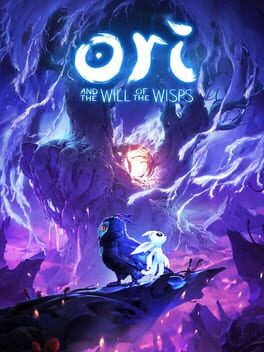The Ori games suffer from the same fundamental flaw as all "cinematic platformers": their striving after beauty, spectacle, and drama directly undermines their gameplay by prioritizing aesthetic and narrative splendor & awe over clarity and autonomy.
In my review for 1991's Another World—a progenitor of the cinematic platformer subgenre—I wrote about how "I didn't feel like my failures were teaching me to play the game as a whole, I just felt like they were teaching me the particulars of each level design." Ori avoids this problem throughout most of its gameplay, but it falls into the same trap any time it leans into the cinematic.
Every boss fight inevitably involves an initial adjustment period (usually requiring dying one or two times) of figuring out just which parts of your gargantuan opponent taking up half the screen is safe to touch and which parts will cause you damage — a question made more complicated, and more frustrating, by each boss having not only highly elaborate "cinematic" attack animations, but multiple phases typically bridged by "cinematic" transitions, complete with environmental transformations. Each of these transitions presents new, never before encountered and completely unpredictable ways of more or less instantly killing the player.
The chase sequences (an oft-relied upon trope) exacerbate the issue: the game expects you to follow a precise sequence of particular moves, with a narrow window of error, in order to make your "by the skin of your teeth" getaway from the big bad. In each of these sequences there are at least one or two moments where the specific action required of you is incredibly opaque due merely to the environment design prioritizing sheer visual spectacle over clarity of communication, and it's only through trial and error and repeated death that one figures out what's required to advance. Ultimately, successfully completing each of these sequences requires no ingenuity on the player's part and allows for no creativity in problem solving. It's simply a matter of following a tightly choreographed script to the letter, as the player is relegated to a performer within a cutscene, a gameplay mode with only one degree more sophistication than the dreaded "quick time event."
And I haven't even mentioned all the platforming sections where glowing, blown out, lens flare-laden backgrounds blend in completely with your character, making it impossible to see wtf you're doing!
I suspect many will see all this as nitpicking. Fair enough. Don't get me wrong: for the most part these games are incredibly solid platformers; exceptional and innovative, even. Hence my four star rating. But I think they fall short of the "masterpiece" status so many seem intent on conveying them. And the reasons for why they miss the mark mostly come down to being unable to make up their mind whether they want to be video games or Pixar movies.
In my review for 1991's Another World—a progenitor of the cinematic platformer subgenre—I wrote about how "I didn't feel like my failures were teaching me to play the game as a whole, I just felt like they were teaching me the particulars of each level design." Ori avoids this problem throughout most of its gameplay, but it falls into the same trap any time it leans into the cinematic.
Every boss fight inevitably involves an initial adjustment period (usually requiring dying one or two times) of figuring out just which parts of your gargantuan opponent taking up half the screen is safe to touch and which parts will cause you damage — a question made more complicated, and more frustrating, by each boss having not only highly elaborate "cinematic" attack animations, but multiple phases typically bridged by "cinematic" transitions, complete with environmental transformations. Each of these transitions presents new, never before encountered and completely unpredictable ways of more or less instantly killing the player.
The chase sequences (an oft-relied upon trope) exacerbate the issue: the game expects you to follow a precise sequence of particular moves, with a narrow window of error, in order to make your "by the skin of your teeth" getaway from the big bad. In each of these sequences there are at least one or two moments where the specific action required of you is incredibly opaque due merely to the environment design prioritizing sheer visual spectacle over clarity of communication, and it's only through trial and error and repeated death that one figures out what's required to advance. Ultimately, successfully completing each of these sequences requires no ingenuity on the player's part and allows for no creativity in problem solving. It's simply a matter of following a tightly choreographed script to the letter, as the player is relegated to a performer within a cutscene, a gameplay mode with only one degree more sophistication than the dreaded "quick time event."
And I haven't even mentioned all the platforming sections where glowing, blown out, lens flare-laden backgrounds blend in completely with your character, making it impossible to see wtf you're doing!
I suspect many will see all this as nitpicking. Fair enough. Don't get me wrong: for the most part these games are incredibly solid platformers; exceptional and innovative, even. Hence my four star rating. But I think they fall short of the "masterpiece" status so many seem intent on conveying them. And the reasons for why they miss the mark mostly come down to being unable to make up their mind whether they want to be video games or Pixar movies.
